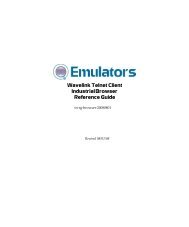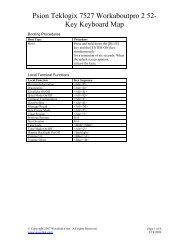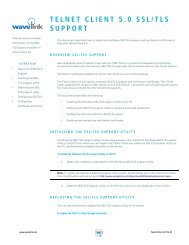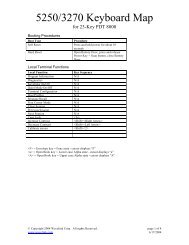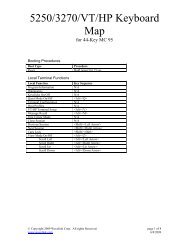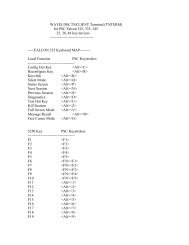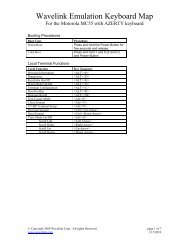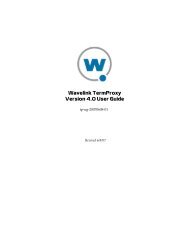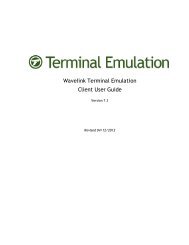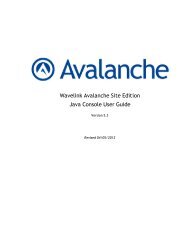- Page 1 and 2:
Wavelink Avalanche Site Edition Jav
- Page 3 and 4:
Table of Contents 1 Table of Conten
- Page 5 and 6:
Table of Contents 3 Configuring Sch
- Page 7 and 8:
Table of Contents 5 Mobile Device P
- Page 9 and 10:
Chapter 1: Introduction 7 Chapter 1
- Page 11 and 12:
Chapter 1: Introduction 9 • Locat
- Page 13 and 14:
Chapter 1: Introduction 11 Once you
- Page 15 and 16:
Chapter 2: Installing Avalanche 13
- Page 17 and 18:
Chapter 3: Licensing 15 variety of
- Page 19 and 20:
Chapter 3: Licensing 17 Figure 3-1.
- Page 21 and 22:
Chapter 3: Licensing 19 To import a
- Page 23 and 24:
Chapter 3: Licensing 21 NOTE If you
- Page 25 and 26:
Chapter 4: Avalanche Console 23 Cha
- Page 27 and 28:
Chapter 4: Avalanche Console 25 •
- Page 29 and 30:
Chapter 4: Avalanche Console 27 Pro
- Page 31 and 32:
Chapter 4: Avalanche Console 29 Whi
- Page 33 and 34:
Chapter 4: Avalanche Console 31 3 I
- Page 35 and 36:
Chapter 4: Avalanche Console 33 Sch
- Page 37 and 38:
Chapter 4: Avalanche Console 35 Con
- Page 39 and 40:
Chapter 4: Avalanche Console 37 Par
- Page 41 and 42:
Chapter 4: Avalanche Console 39 Fro
- Page 43 and 44:
Chapter 4: Avalanche Console 41 NOT
- Page 45 and 46:
Chapter 5: Managing User Accounts 4
- Page 47 and 48:
Chapter 5: Managing User Accounts 4
- Page 49 and 50:
Chapter 5: Managing User Accounts 4
- Page 51 and 52:
Chapter 5: Managing User Accounts 4
- Page 53 and 54:
Chapter 5: Managing User Accounts 5
- Page 55 and 56:
Chapter 5: Managing User Accounts 5
- Page 57 and 58:
Chapter 6: Managing Sites and Locat
- Page 59 and 60:
Chapter 6: Managing Sites and Locat
- Page 61 and 62:
Chapter 6: Managing Sites and Locat
- Page 63 and 64:
Chapter 6: Managing Sites and Locat
- Page 65 and 66:
Chapter 7: Managing Network Profile
- Page 67 and 68:
Chapter 7: Managing Network Profile
- Page 69 and 70:
Chapter 7: Managing Network Profile
- Page 71 and 72:
Chapter 7: Managing Network Profile
- Page 73 and 74:
Chapter 7: Managing Network Profile
- Page 75 and 76:
Chapter 7: Managing Network Profile
- Page 77 and 78:
Chapter 7: Managing Network Profile
- Page 79 and 80:
Chapter 8: Managing Scan to Configu
- Page 81 and 82:
Chapter 8: Managing Scan to Configu
- Page 83 and 84:
Chapter 8: Managing Scan to Configu
- Page 85 and 86:
Chapter 8: Managing Scan to Configu
- Page 87 and 88:
Chapter 8: Managing Scan to Configu
- Page 89 and 90:
Chapter 9: Managing the Mobile Devi
- Page 91 and 92:
Chapter 9: Managing the Mobile Devi
- Page 93 and 94:
Chapter 9: Managing the Mobile Devi
- Page 95 and 96:
Chapter 9: Managing the Mobile Devi
- Page 97 and 98:
Chapter 9: Managing the Mobile Devi
- Page 99 and 100:
Chapter 9: Managing the Mobile Devi
- Page 101 and 102:
Chapter 9: Managing the Mobile Devi
- Page 103 and 104:
Chapter 10: Managing Software Profi
- Page 105 and 106:
Chapter 10: Managing Software Profi
- Page 107 and 108:
Chapter 10: Managing Software Profi
- Page 109 and 110:
Chapter 10: Managing Software Profi
- Page 111 and 112:
Chapter 10: Managing Software Profi
- Page 113 and 114:
Chapter 10: Managing Software Profi
- Page 115 and 116:
Chapter 10: Managing Software Profi
- Page 117 and 118:
Chapter 10: Managing Software Profi
- Page 119 and 120:
Chapter 10: Managing Software Profi
- Page 121 and 122:
Chapter 11: Managing Mobile Devices
- Page 123 and 124:
Chapter 11: Managing Mobile Devices
- Page 125 and 126:
Chapter 11: Managing Mobile Devices
- Page 127 and 128:
Chapter 11: Managing Mobile Devices
- Page 129 and 130:
Chapter 11: Managing Mobile Devices
- Page 131 and 132:
Chapter 11: Managing Mobile Devices
- Page 133 and 134:
Chapter 11: Managing Mobile Devices
- Page 135 and 136:
Chapter 11: Managing Mobile Devices
- Page 137 and 138:
Chapter 11: Managing Mobile Devices
- Page 139 and 140: Chapter 11: Managing Mobile Devices
- Page 141 and 142: Chapter 11: Managing Mobile Devices
- Page 143 and 144: Chapter 11: Managing Mobile Devices
- Page 145 and 146: Chapter 11: Managing Mobile Devices
- Page 147 and 148: Chapter 11: Managing Mobile Devices
- Page 149 and 150: Chapter 12: Managing Mobile Device
- Page 151 and 152: Chapter 12: Managing Mobile Device
- Page 153 and 154: Chapter 12: Managing Mobile Device
- Page 155 and 156: Chapter 13: Managing Alert Profiles
- Page 157 and 158: Chapter 13: Managing Alert Profiles
- Page 159 and 160: Chapter 13: Managing Alert Profiles
- Page 161 and 162: Chapter 13: Managing Alert Profiles
- Page 163 and 164: Chapter 13: Managing Alert Profiles
- Page 165 and 166: Chapter 14: Using Selection Criteri
- Page 167 and 168: Chapter 14: Using Selection Criteri
- Page 169 and 170: Chapter 14: Using Selection Criteri
- Page 171 and 172: Chapter 14: Using Selection Criteri
- Page 173 and 174: Chapter 14: Using Selection Criteri
- Page 175 and 176: Chapter 14: Using Selection Criteri
- Page 177 and 178: Chapter 14: Using Selection Criteri
- Page 179 and 180: Chapter 14: Using Selection Criteri
- Page 181 and 182: Chapter 15: Using the Task Schedule
- Page 183 and 184: Chapter 15: Using the Task Schedule
- Page 185 and 186: Appendix A: SSL Certificates 183
- Page 187 and 188: Appendix A: SSL Certificates 185 Ge
- Page 189: Appendix A: SSL Certificates 187 3
- Page 193 and 194: Appendix A: SSL Certificates 191 ke
- Page 195 and 196: Appendix B: Avalanche Services 193
- Page 197 and 198: Appendix C: Port Information 195 Mo
- Page 199 and 200: Glossary 197 Glossary ActiveSync Ad
- Page 201 and 202: Glossary 199 ESSID Exclusion Window
- Page 203 and 204: Glossary 201 Remote Control Scan to
- Page 205 and 206: Index 203 Index A activating Avalan
- Page 207 and 208: Index 205 scheduled settings 66 WLA




